“IT’S A DIFFERENT race of deer up there,” Tim Trefren said as we pulled dusty saddles and sweaty blankets off our horses. Tim’s mount was a classy roan named Red. They called mine Propane Tank, both for his rotundity and for his habit of releasing an audible quantity of gas with nearly every step. “Up there” was a high ridge above the wall tents and lodgepole corral of Tim’s remote Wyoming hunting camp. We had just ridden down that steep ridge in the dark, our horses’ hooves throwing sparks every time their shoes nicked a rock in the trail. To me, in the dark atop a farting horse, the sparks looked like terrestrial versions of the shooting stars we had seen early that morning as we ascended the ridge, the Milky Way smeared across the sky.
The ridge is called the Greyback. Geologists would tell you it’s the upthrust portion of a subduction zone, vertical evidence of one of the continent’s growth plates. I’d guess it got its name because the miles-long hogback is punctuated by rocky heights that make it look like a giant’s backbone. And because it separates the Greys River watershed from that of the Hoback River to the east.
Whatever its derivation, the Greyback presides over gamey country in the Wyoming Range of western Wyoming. Tim, owner of Trefren Outfitters, and I had hunted elk since daybreak in the timberline basins that slide off the eastern side of the ridge. We had been in elk all day, and had seen moose, black bears, and even bighorn sheep on the distant red-rock slopes of Hoback Peak. Looking north from the highest points of the ridge, we could see the jagged crest of Grand Teton hovering above the town of Jackson like a snowy fang. We hadn’t gotten a shot at a bull, but soon after we mounted our horses for the long switchback ride down the ridge, we spotted a heavy-antlered animal crossing the trail in front of us. In the weak light of evening, it looked like a bull elk.
“That’s a helluva buck,” Tim whispered from the saddle, watching the mule deer disappear into the dark. “A helluva buck.”
Now, at the corrals, brushing down the horses and hanging saddles in the tack tent, Tim talked about the deer.
“We used to see bucks like that pretty regularly, back in the ’50s and ’60s,” Tim said. “Some hunters called them mossbacks, but most around here called them greybacks. They were just bigger—maybe 50 percent larger in body size than your typical mule deer. And their antlers… Well, there were some mighty fine racks that came out of that country back there.” Tim waved his curry brush back up toward the ridge.
I knew some of that history. The one-time world-record mule deer hailed from the Hoback. Back in the 1920s, a hunter killed the wide-racked buck for meat and left the skull behind. The antlers were picked up and found their way to a succession of bars, ending up at the Jackson Hole Museum, where you can still admire their dimensions: 217 inches of bone, enough to remain in the record book as the third-largest typical mule deer buck of all time.
“This was all horse country back then,” Tim continued. “If you wanted to hunt the Hoback, you had to plan to spend a week on your horse. Then the Jeeps started stabbing in, and the trails turned into roads. A guy in a chained-up Willy could hunt the Hoback in a couple days. Those big deer started getting harder and harder to find, to the point I’d almost say they’re extinct.”
Tim bucked his saddle on to its rack in the tack tent and spilled oats out of a Folgers can for the horses.
“Be something to turn up one of them greybacks.”
Camp Trefren
That was six years ago, but I never forgot about that buck. I didn’t shoot a Hoback bull with Tim, but later that season I killed a cow in the company of Tim’s son, also named Tim and called Junior around camp. In that season and over the next couple, I got to know the Trefrens and their main guide, Greg Kriese, like extended family. Tim Jr. kept inviting me to hunt with him, and I kept going—sometimes by myself, sometimes with friends—with a nonresident deer tag when I could draw one, with an elk tag when I couldn’t. Usually they gave me Propane Tank to ride.
My friendship with the clan grew so strong that I felt the blow when Tim Jr. called with the news. “Dad died last night. Funeral is in Thayne on Saturday. It would mean a lot to all of us if you could make it.”
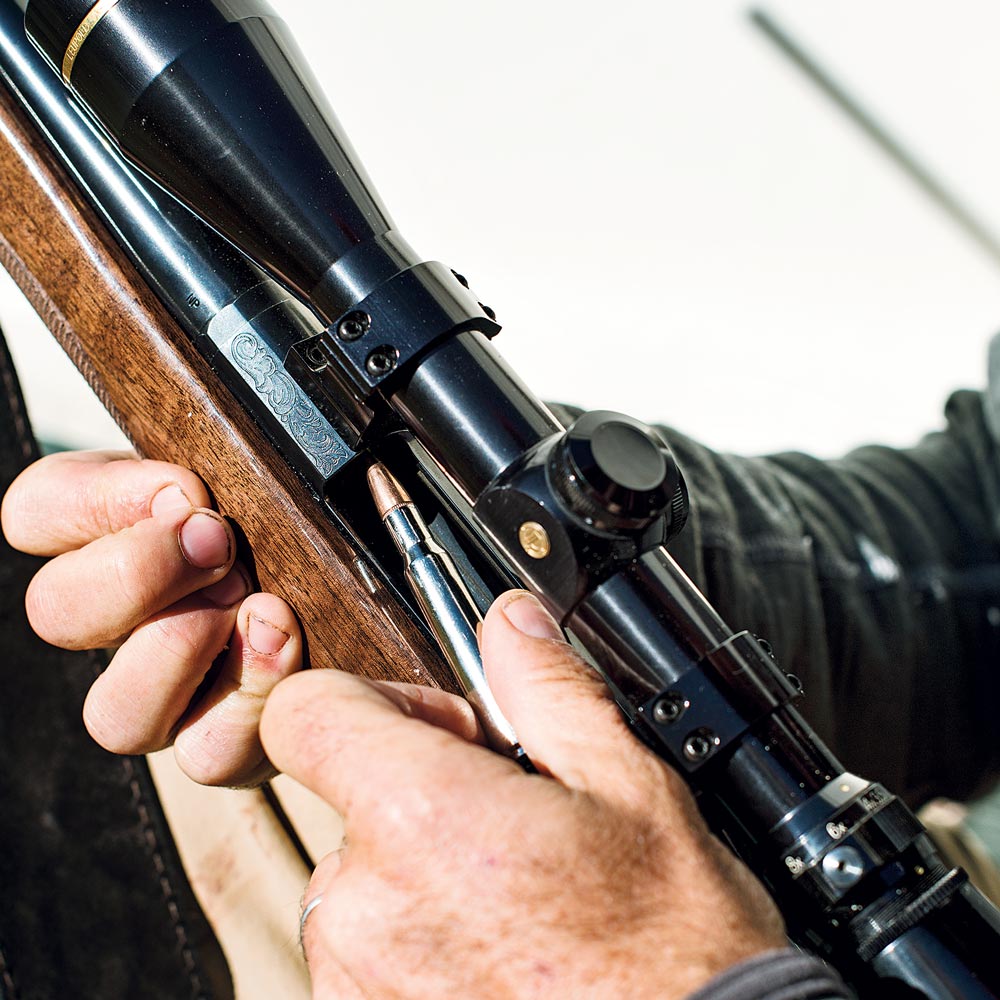
I can’t recall the obligation that kept me away from Thayne that day, but I still feel guilty that I wasn’t there to send off Tim Sr., his empty saddle cinched on Red, his body in a horse-drawn hearse driven down Main Street by his son.
I also can’t recall what kept me from hunting with Tim Jr. and Greg that year, but I was determined to return to the Wyoming Range last fall. I had a preference point for a deer tag and had set aside a week in September for the Region H buck season. Then my friend Mike Stock called with a proposition. Mike is the centerfire ammunition product manager for Winchester, which has a longtime partnership with Browning. He had advised Browning on the development of a new line of ammunition. The iconic Buckmark would be imprinted on the cartridges’ headstamps. Mike is also one of my favorite hunting partners, and we try to get out in the field together at least once every season.
Let’s go deer hunting, Mike said, and be the first hunters to use Browning’s new Buckmark ammo in the field. Where should we go?
The answer leapt from my lips: The Wyoming Range.
That’s the abbreviated story of how Mike and I found ourselves pulling into the Trefrens’ wall-tent camp in late September, Browning rifles and ammo ready to go to work atop the Greyback. As I drove into camp, sun sifting through the lodgepole pine needles and little grey squirrels sprinting across the road, I felt a little like I was coming home. I wondered which horse I’d get dealt this year.
Mule Deer Country
Mike hadn’t been a hard sell on Wyoming. There are other great places to hunt big mule deer—southern Utah, Colorado’s Western Slope, Arizona’s Kaibab Plateau, Oregon’s Blue Mountains, southeastern Idaho—but few with the history of the Wyoming Range.
I told Mike about my own background with the place—not only the monster buck I had spied with Tim Sr., but even before that, the pictures of heavy-racked, non-typical Greys River deer I had drooled over as a young Western hunter obsessed with big mule deer.
The Wyoming Range is legendary among trophy mule deer hunters. Maybe it’s the reputation of the Hoback Buck, but for years the range was known for its high-country muleys—tall, heavy, non-typical bucks that summered in the subalpine basins of wildflowers and jack pine and wintered in the sagebrush desert that stretches east toward the Wind River Range.
Then word started trading among deer hunters that the Wyoming Range’s reputation was slipping. The state is issuing too many hunting tags, said some. It’s the drought, said others. But there was one undeniable consistency: Too many deer were dying out on the winter range.
Over the past couple of decades, much of that high-basin sagebrush has been impaired by gas wells, service roads, and power lines. When habitat becomes fractured, long, hard winters can be catastrophic for mule deer, especially when they follow droughty summers that leave the animals in poor physical condition. Trophy mule deer need five or six years to reach maturity, and tough winters come around about once a decade. The math suggests that weather and winter-range energy production may have as much impact on the Wyoming Range’s mossbacks as Jeeps had.
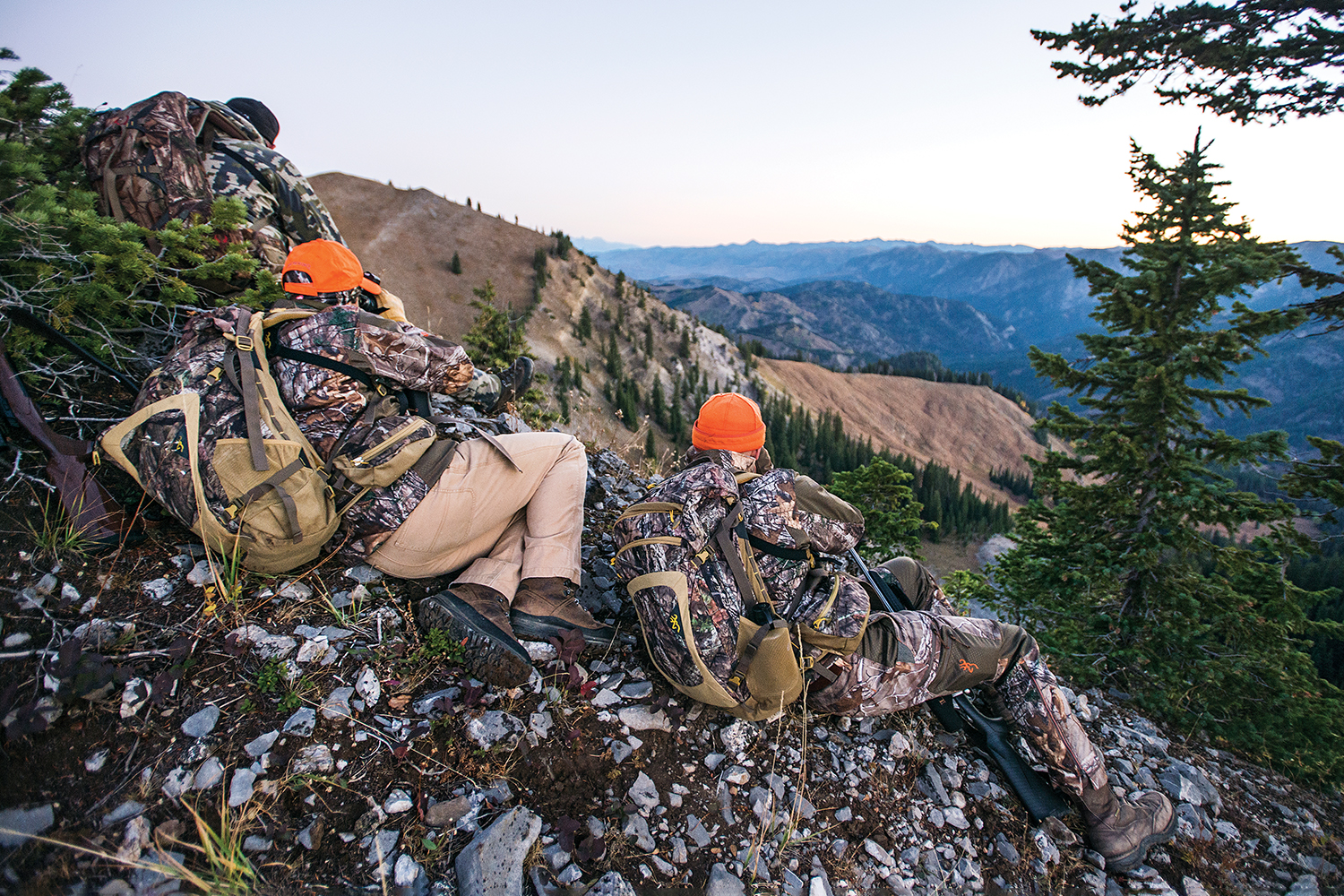
After I explained this dynamic to Mike, I could tell he was deflated. We were here to hunt big mule deer, but I made it sound like he should shoot the first forkhorn he saw.
“Relax,” I said as we settled into our canvas wall tent. “If any folks know big deer, it’s Junior and Greg.” But silently, I was worried. I had hunted here for years and had never had a deer in my sights that I wanted to shoot.
Up the Greyback
The camp’s daily ritual isn’t for night owls. Up at 4 a.m., breakfast in the cook tent, then in saddles by 5 and on the Greyback trail a couple of hours before light. The idea is to be in the high basins by sunup, glassing with binoculars for deer moving to their day beds. My horse this year: Hoback. Mike’s: Dickhead. Matt Nager, our photographer, rode Ugly Betty. Junior had to attend to work in town, so Greg, astride Red Ryder, guided us.
On our first morning on the ridge, Greg spotted a heavy-racked 4-point moving across a bowl, and it seemed a cinch to circle around the back side of the basin and shoot him when he walked into view on a game trail just below us. Only, after we waited a couple of hours, the buck never showed.
It’s like that in these high parks. What appears from a distance to be a featureless meadow is cut with gullies and fissures deep enough to funnel a deer out of danger.
So we hiked back to our horses and rode south in the midday heat, planning to eat lunch at the head of a series of basins that Greg said might be productive. Lunch is a highlight of any hunt with the Trefrens. Two sandwiches with condiments, a couple bags of chips, candy bars and granola bars, little pudding cups. Fruit Jell-O. An assortment of hard candies. It’s any fourth-grader’s fantasy grab bag. And it was all mine, in the most handsome lunchroom a big-game hunter could imagine.
As I settled against a fir trunk with my lunch bag, Greg pointed toward a strip of stunted pine that ran 1,000 yards away, from the middle of the steep basin toward the rim. “Keep an eye on that cover,” he said. “I guarantee there’s game in there.”
The sun was hot and the sandwiches tranquilizing, and every 30 minutes or so, I roused myself out of a haze to glass the jack pines. In midafternoon, I heard Greg whisper from behind his spotting scope.
“I got something here.” An urgency in his voice made me sit up straight. He fiddled and focused the scope and let out a deep breath. “Holy hell. That’s a giant.” Just like that, my lunch lethargy was gone as Mike, Matt, and I fought for position behind the scope. I scrunched my eyes in the optic. The heat was throwing up a shimmer, so the animal bedded in the shade of the pines looked like a deer in a fever dream, swimming in and out of focus. But I could make out its blocky body, double throat patch, and tall antlers blonde as straw.
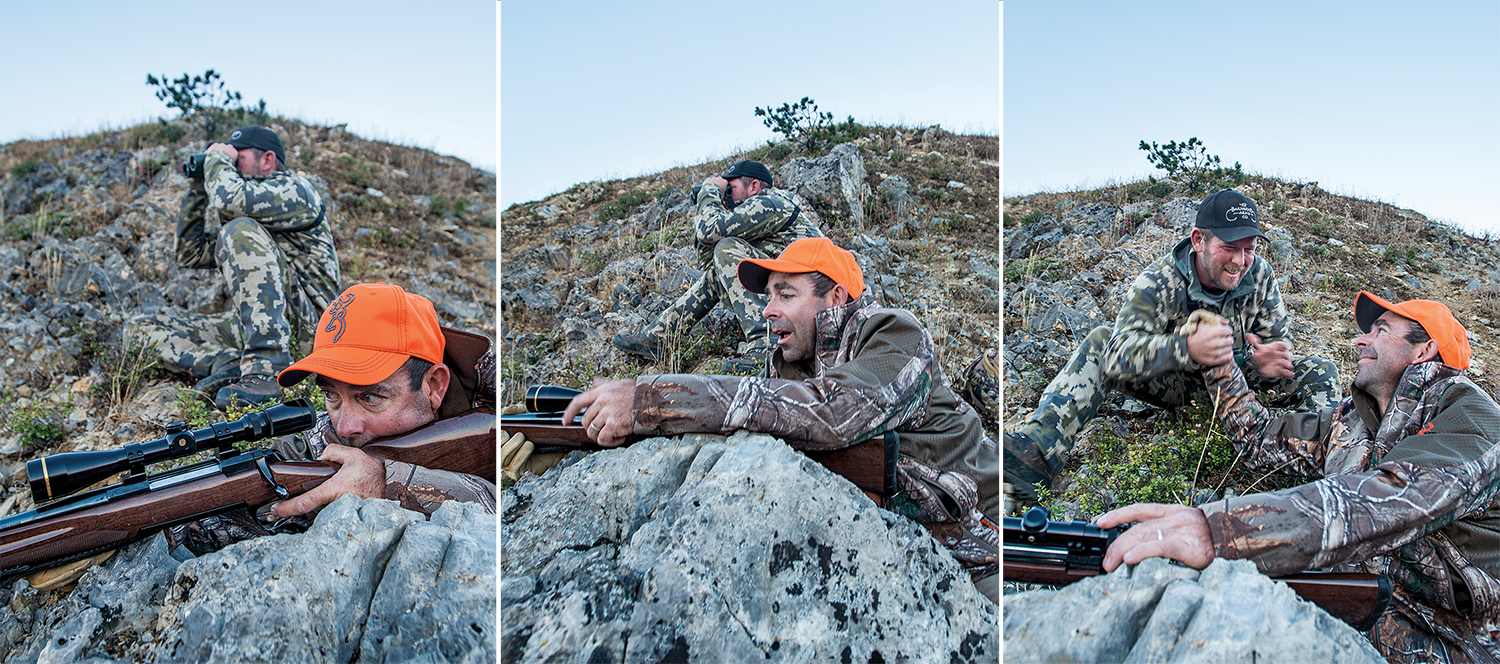
If you’ve ever seen a trophy animal at an impossible distance, then you know that two things happen. First, you can’t stop looking at him, sizing up his headgear and wondering just how you might actually kill him. Second, you get a little paralyzed. To sit there and stare is easy and without consequence. To actually make a move ruins the perfection of possibility. What if he sees us and bolts? Or what if we blow our stalk and run him out of the basin. Or what if he simply walks into the scrubby pines and out of our sight? For nearly an hour we admired him, shooting video on our cell phones through the spotter and debating his dimensions.
I knew we’d have to move to kill him. We were 925 yards away, with no way to get closer on a straight line. We’d have to drop off our little ridge, hike to the top of the basin, and either take a long shot from above or work down into the basin without busting him.
Afterburners
I led the way, moving with purpose, with the others behind me. Here was possibly the largest mule deer I had ever seen in the flesh, and he was alarmingly aware. As we had watched him for that hour, he had gotten up from his bed three times. Every time he bedded back down, he situated himself so that he could scan the rim of the basin. Watching him, I realized here was a deer who knew the source of danger—the horse trail at the top of the ridge—and he knew how to avoid it, by staying in cover all day. The only place to spot him was from our lunch perch.
To kill him, we’d have to do everything right, so I made sure my profile was hidden by the ridge, that I didn’t knock an errant rock down the slope, and that I had a plan.
That plan was to gain the rim of the bowl and then to range the buck. I reckoned we’d be about 600 yards out, a long shot with my .30/06 and 185-grain Browning bullets even if I wasn’t shooting at an extreme downhill angle. But maybe, just maybe, a solution would reveal itself from the rim.
By the time we climbed to the top and assessed the situation from the rim of the basin, the sun was sinking low in the west. Worse, the buck was obscured by a little finger of rocks we hadn’t factored in from below. If I was going to kill this deer, I was going to have to enter his world: the steep, stony heart of the bowl.
I’d have to go alone, leaving my crew behind at the top to watch the action. But I’d also need an assurance the deer was still in the pines. So Greg sent Mike back to the spot from where we had originally seen the buck. If he was still in sight, Mike would raise his arms like a football referee signaling a touchdown. If he wasn’t there, Mike would sweep his hands horizontally, as though signaling an incomplete pass.
I dropped my pack and binocular, stuffed extra shells in my pockets, and pulled leather gloves on my hands. I felt like an Olympic mogul skier, about to drop into the run, so steep and gnarly was the terrain in front of me.
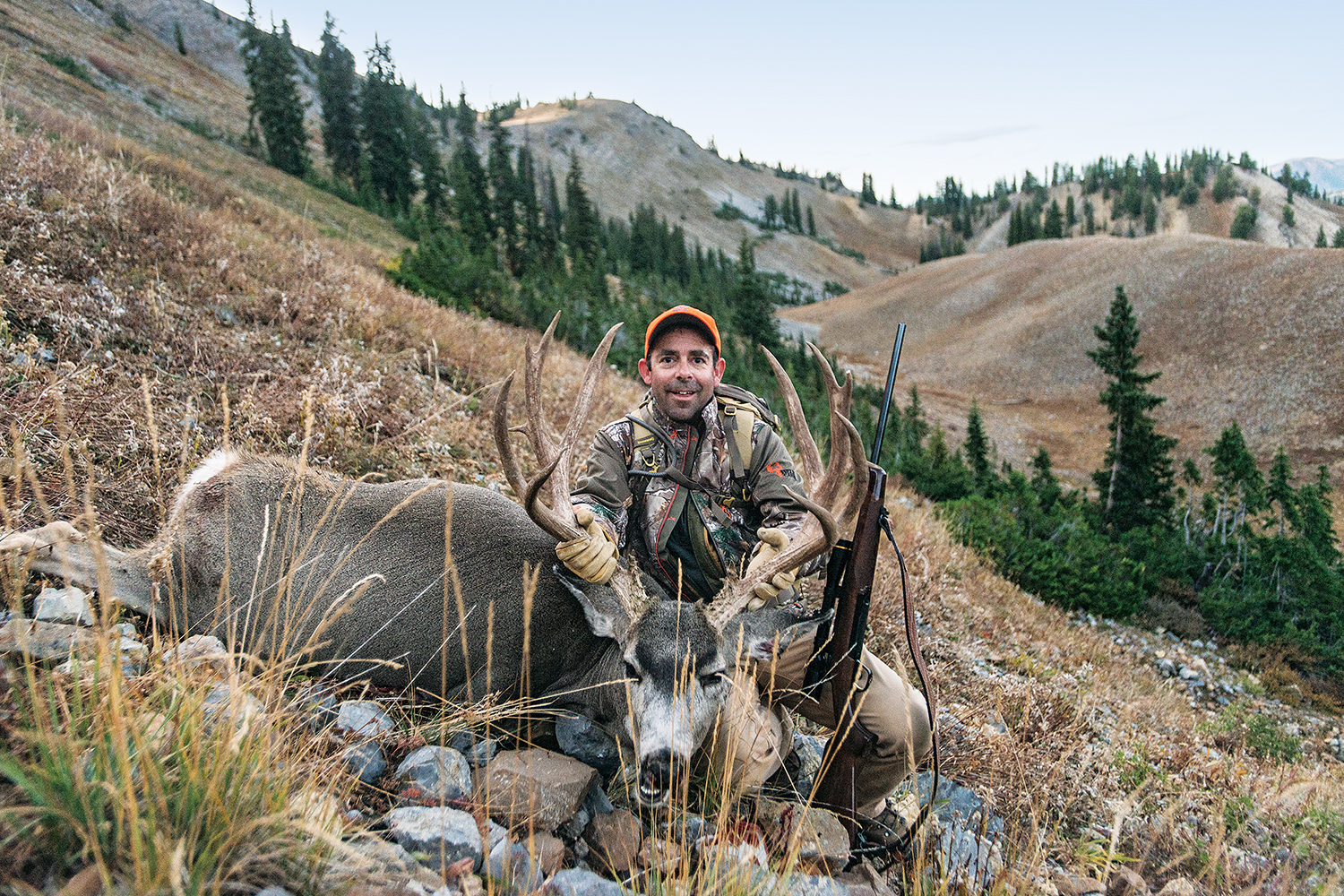
I took a couple of steps downhill and immediately knocked loose a fist-sized rock. It tumbled, caught air, and then clattered down the bowl, sounding like a lawn chair thrown down a stairway. No deer would stand for a racket like that.
I took a couple more mincing steps on the slope, trying to keep my balance and retain my stealth. Another rock rolled. How would I ever get to that rise of rocks undetected? I steeled myself. I’d simply have to sprint and hope to intercept the deer. I started to stride, only it was a cartoon sprint, on a 60-degree slope, the ankle-turning cobble trying to spill me on my butt, and rocks careening into thin air. My beautiful high-country buck surely must be in Idaho by now.
Then something surreal and impossible happened. Mid-stride, hyper-aware of the cacophony I was causing, I heard a noise quite unlike clattering rock. It was sudden, shrieking, and sky-fillingly loud, and I immediately realized it would cover my noise. I pitched down the bowl, windmilling my arms, using my rifle as a counterweight to keep my feet, dead-set on making the outcrop.
I reached the rock just as the source of the noise—two fighter jets—screamed over the Greyback, low enough for me to see rivets in their wings. I have no idea whether their low-altitude run is a regular occurrence, only that their timing this evening was a godsend. Just as quickly as they’d arrived, they were gone, and the high-mountain silence returned. I peered over the rock, and there was the line of pines 200 yards below me. But there was no buck in sight. I glassed through my riflescope, hoping to see an antler or an ear. Nothing. I was losing light fast, and felt a little surge of panic. Was the buck gone?
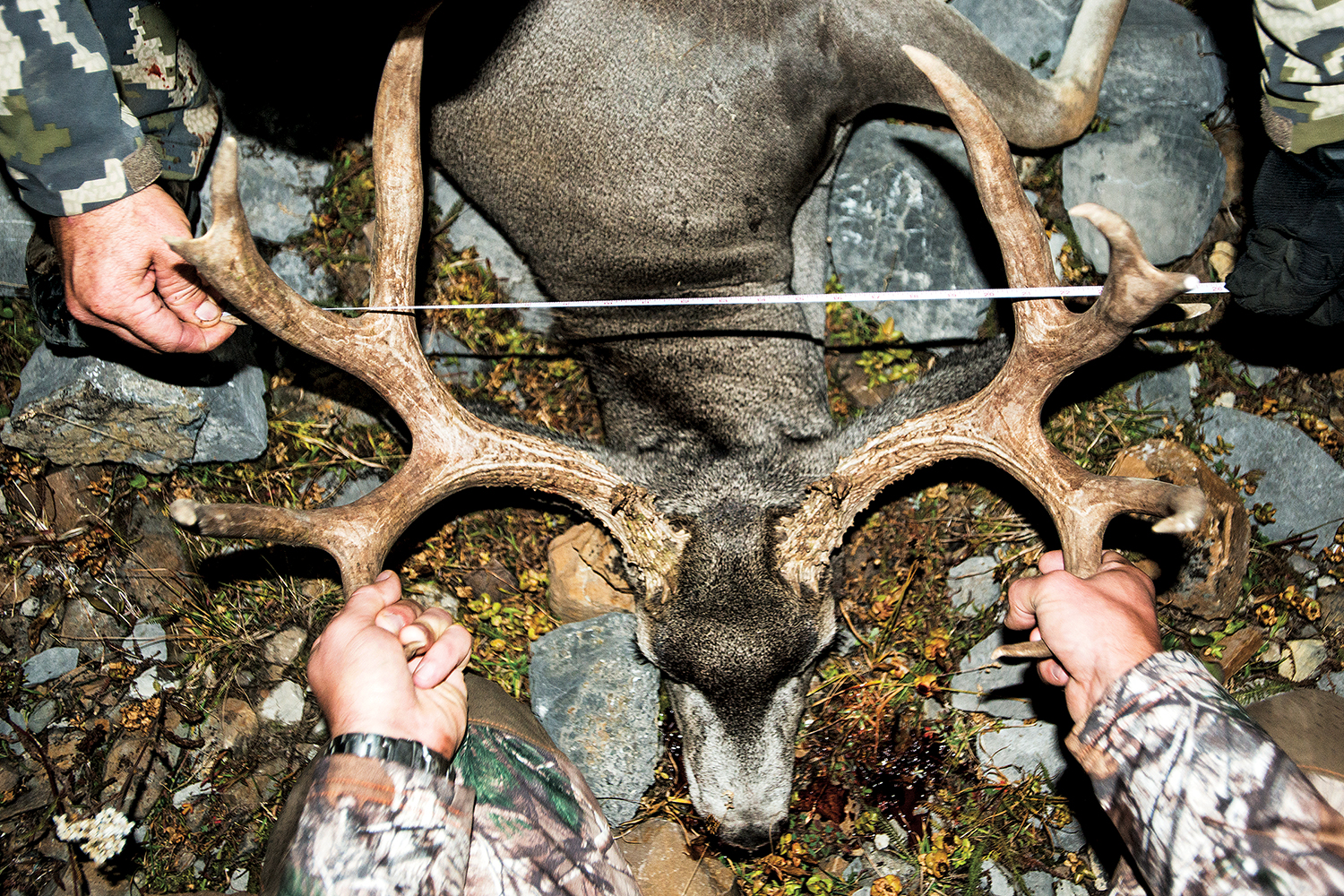
I turned and looked back up at the rim at Greg. Four hundred yards above me, silhouetted by the glowing sky, I could see Greg’s sign, his hands high in the air. The buck was still there. I was stuck on my rock, unable to move without dislodging more scree. My only choice was to wait and hope the buck might rise from his bed while I still had enough light to shoot.
The Buckmark
I laid my leather gloves on the rough granite, and then the forend of my .30/06 X-Bolt on the gloves. I could only wait, and fret about the failing light.
When I saw the deer, he was feeding uphill, most of his body obscured by pine branches, but I knew it was him by his blocky body and tallow-ivory antlers. With no clear shot, I had to wait excruciatingly long minutes, glassing through my riflescope, until he was clear of bullet-deflecting obstructions. He was quartering away at a distance I estimated at 260 yards, but my rest was literally rock-solid. In the echoey bowl, my rifle shot sounded louder than the jets.
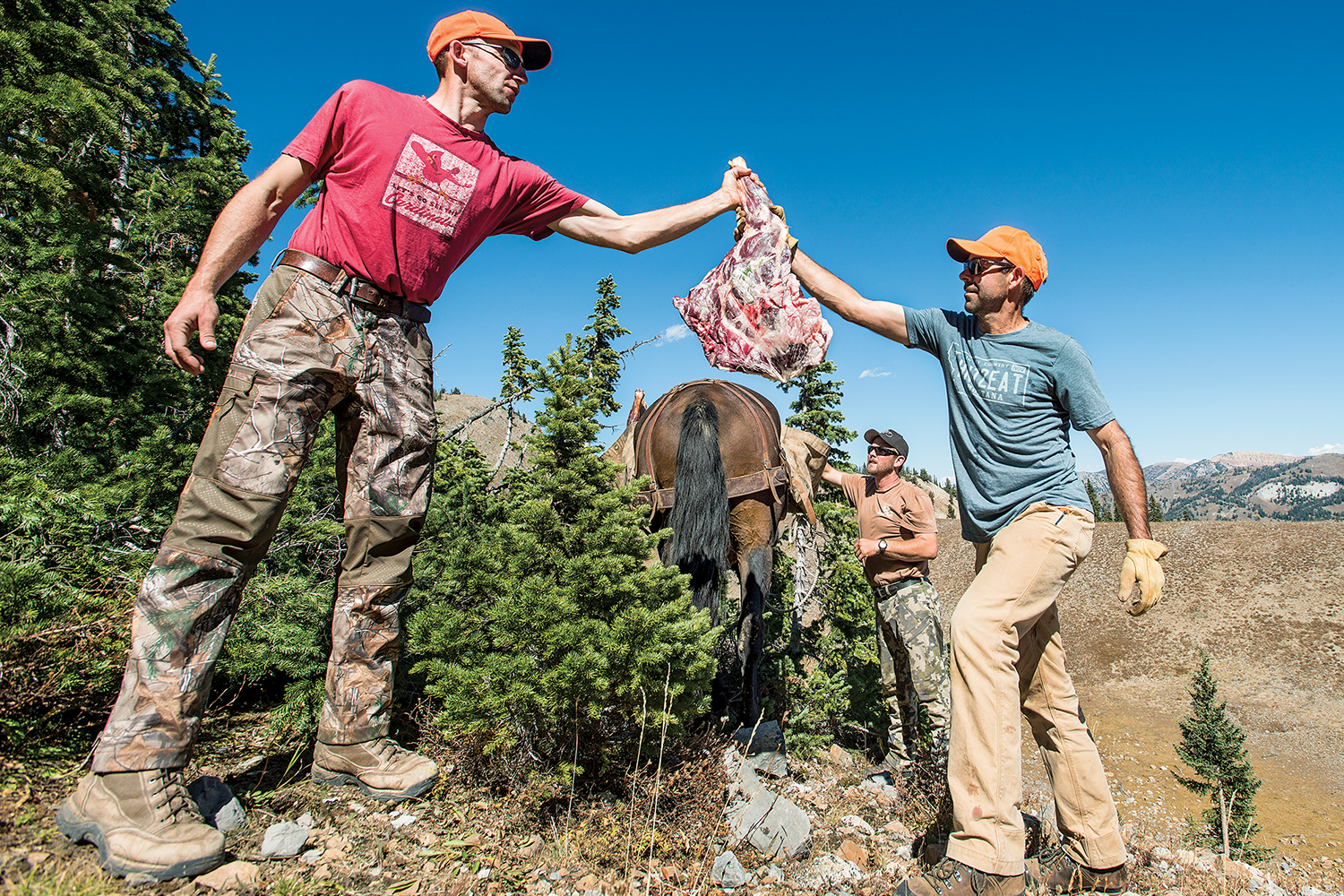
I waited for Mike to reach my perch, and the two of us walked to the buck while Greg and Matt came with the packs. The deer had cartwheeled down the scree after the hit, and it was nearly dark when we reached him. Normally, I would have held his antlers first, but what took my breath away was his body size. He was as large as a spike bull, with immense hindquarters and a barrel chest. I was marveling at his physical dimensions when Mike started laughing. “He looks just like the Buckmark,” he said, and I noticed that he did: The deep forks and long tines of the antlers might pass, in this flimsy light at least, for the iconic logo of the bullet I had just used to kill him.
When Greg and Matt arrived, we took photos and then started taking apart the deer. Our backpacks weren’t stout enough to haul all the meat, and it would take too long to hike out of the basin for the horses. So we quartered the buck and draped meat across the boughs of subalpine fir trees. I tied an orange vest to a tree and then urinated all around the little grove. This is lion and bear country, and I hoped the scent might deter scavengers until we could return in the morning with a pack horse.
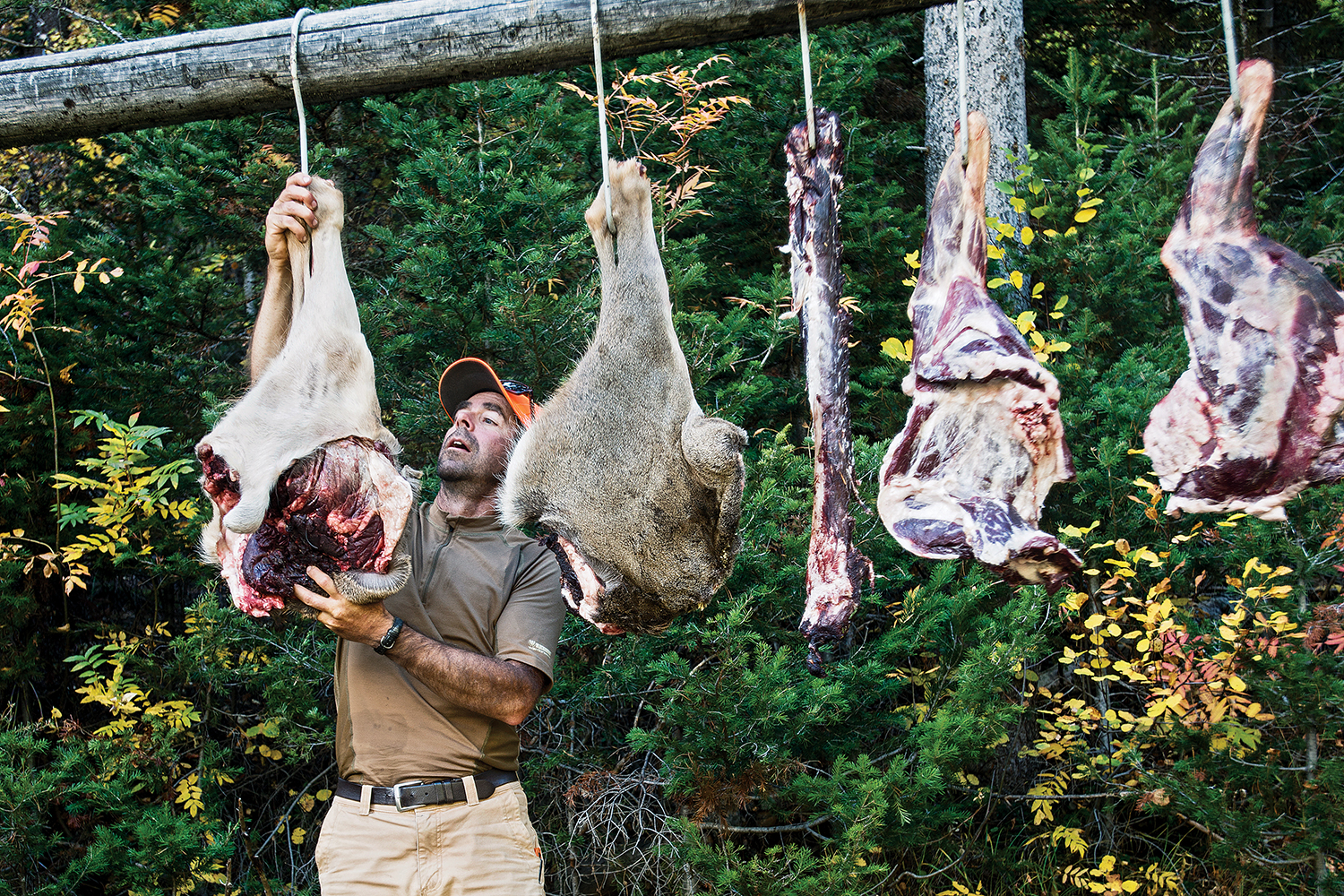
In the dark of a moonless night, the hike out of the basin was long and strenuous. We reached the horses at midnight. I can’t recall a more enjoyable ride than that one, my hands caked with deer blood, the only sounds the tick of horses’ hooves on rocks and the creak of tired leather. I’m pretty sure my smile could have been seen from the satellites that streaked overhead, little pinpoints of light arcing against the deep stars.
I had killed my biggest mule deer, in one of my favorite hunting grounds, with a group of close friends. I could almost hear Tim Sr. ahead of me on Red. “Be something to turn up one of them greybacks…”.

This story was originally published in the September 2016 issue of Outdoor Life. Read more OL+ stories.
